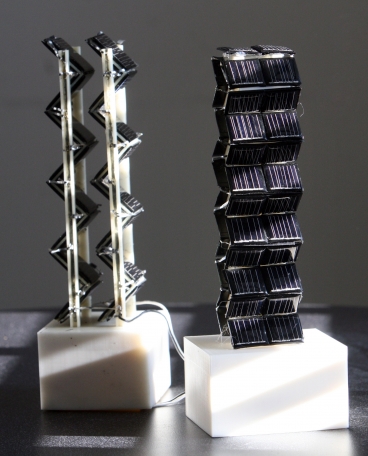Industry
MIT Cubic Solar Energy Design
By Carson Riley
| Reading time 1 minute
Researchers at MIT are hard at work on the problem of solar efficiency, and lowering the cost per kilowatt on solar panels. A few weeks ago, senior researcher Jeffrey Grossman presented his findings on a new type of solar architecture published in the journal of Energy and Environmental Science, which he claims can “open new avenues towards Terawatt scale generation.”
 Cubic solar design pioneered at MIT
Cubic solar design pioneered at MIT
Grossman and his team found that while intuitively it makes sense to lay solar panels flat in order to capture the trajectory of the sun’s beams, the two-dimensional panels miss out on the vast majority of possible power production throughout the day, in order to capture the short term benefits during the pinnacle of on-peak production. Cubic designs help capture solar energy at a more stable baseline throughout the day, and “can nearly double the number of peak hours available for solar energy generation, provide a measured increase in the energy density by a factor of ~2–20 without sun tracking with even higher figures in the case of cloudy weather, and reduce the large variability in solar energy generation with latitude and season found in non-tracking flat panels.”
Using Monte Carlo and generic algorithm simulation standards, the team has shown that the two main forces making this design so successful is: the avoidance of intercell shading, and the utilization of reflected light from respective solar panels onto others. This not only gives an amplified output of solar production, but it also makes the generation capacity more predictable, as more factors are under the control of the design itself, as opposed to big ball in the sky we call the sun.
Solar manufacturers haven’t begun implementing this design in their products yet, but the first ones to do so will benefit from a significant comparative advantage. (Assuming they can find an economically efficient method of constructing them). This new construction design will open all sorts of doors for energy businesses and enthusiasts looking to maximize demand response capability, distributed generation capacity, and smart grid development. Thanks to the contribution of these researchers, the day just got a little brighter in the world of solar development.
Also in Industry
Apps for Energy Competition Announced by the Department of Energy
By Eric Danziger | Apr 10, 2012
Genability Supports Fast-Growing Green Button Data from the DOE
By Eric Danziger | Mar 23, 2012
An Insight into Net Metering
By Carson Riley | Mar 16, 2012
Cleanweb Hackathon 2012
By Emile Baizel | Dec 24, 2011

